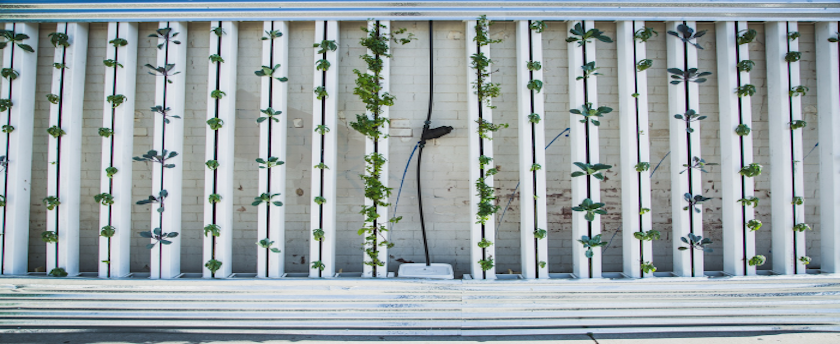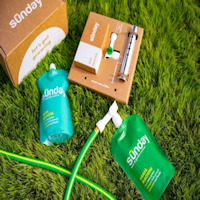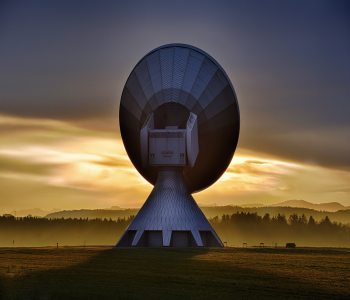
Current technology allows the organic growing industry and the hydroponics, aeroponics, bubbleponics, aquaculture, controlled environment and numerous other sub systems to compete with the more conventional systems. Our systems incorporate wind and solar for the energy supply, re-cooperate %60 of the water used and all our buildings are constructed using only green, sustainable building products. We only use organic nutrients and build our systems larger to handle the heavier thicker liquids that organic nutrients contain.
We carry a complete line of nutrients and fertilizers or you can check out our Organic Fertilizers information page.
Recent reductions in energy usage and a more consistent product with a higher nutritional value plus a more consistent weight and texture in respect to it's size, have brought organic farming closer to mainstream thinking. This will result in greater attention to the industry and stronger focus on such things as vertical farming in major cities. Hang in there guys our day is coming.
System Irrigation
Deep Water Culture BubblePonics Irrigation Ebb And Flow Irrigation Run To Waste Irrigation Organic Engineering Systems Continuous Flow Solution Culture Static Solution Culture Ecological Engineering
Passive Sub-Irrigation
Passive sub-irrigation, also known as passive hydroponics or semi-hydroponics, is a method wherein plants are grown in an inert porous medium that transports water and fertilizer to the roots by capillary action from a separate reservoir as necessary, reducing labor and providing a constant supply of water to the roots. In the simplest method, the pot sits in a shallow solution of fertilizer and water or on a capillary mat saturated with nutrient solution. The various hydroponic media available, such as expanded clay and coconut husk, contain more air space than more traditional potting mixes, delivering increased oxygen to the roots, which is important in epiphytic plants such as orchids and bromeliads, whose roots are exposed to the air in nature. Additional advantages of passive hydroponics are the reduction of root rot and the additional ambient humidity provided through evaporations.
Deep Water Culture
TopIn its simplest form, there is a tray above a reservoir of nutrient solution. Either the tray is filled with growing medium (clay granules being the most common) and planted directly or pots of medium stand in the tray. At regular intervals, a simple timer causes a pump to fill the upper tray with nutrient solution, after which the solution drains back down into the reservoir. This keeps the medium regularly flushed with nutrients and air. Once the upper tray fills past the drain stop, it begins recirculating the water until the pump is turned off, and the water in the upper tray drains back into the reservoirs
.Run To Waste
TopIn a run to waste system, nutrient and water solution is periodically applied to the medium surface. This may be done in its simplest form, by manually applying a nutrient-and-water solution one or more times per day in a container of inert growing media, such as rockwool, perlite, vermiculite, coco fiber, or sand. In a slightly more complex system, it is automated with a delivery pump, a timer and irrigation tubing to deliver nutrient solution with a delivery frequency that is governed by the key parameters of plant size, plant growing stage, climate, substrate, and substrate conductivity, pH, and water content.
In a commercial setting, watering frequency is multi factorial and governed by computers or PLCs.
Commercial hydroponics production of large plants like tomatoes, cucumber, and peppers use one form or another of run to waste hydroponics.
In environmentally responsible uses, the nutrient rich waste is collected and processed through an on site filtration system to be used many times, making the system very productive.
BubblePonics
TopThis is the art of delivering highly oxygenated nutrient solution direct to the root zone of plants. While Deep Water Culture involves the plant roots hanging down into a reservoir of water below, the term Bubbleponics describes a top-fed Deep Water Culture (DWC) hydroponic system. In this method, the water is pumped from the reservoir up to the roots (top feeding). The water is released over the plant's roots and then runs back into the reservoir below in a constantly recirculating system. As with Deep Water Culture, there is an airstone in the reservoir that pumps air into the water via a hose from outside the reservoir. The airstone helps add oxygen to the water. Both the airstone and the water pump run 24 hours a day.
The biggest advantages with Bubbleponics over Deep Water Culture involve increased growth during the first few weeks. With Deep Water Culture, there is a time where the roots have not reached the water yet. With Bubbleponics, the roots get easy access to water from the beginning and will grow to the reservoir below much more quickly than with a Deep Water Culture system. Once the roots have reached the reservoir below, there is not a huge advantage with Bubbleponics over Deep Water Culture. However, due to the quicker growth in the beginning, a few weeks of grow time can be shaved off.
Hydroponic Systems
Static Solution Culture
TopIn static solution culture, plants are grown in containers of nutrient solution, such as glass Mason jars (typically, in-home applications), plastic buckets, tubs, or tanks. The solution is usually gently aerated but may be un-aerated. If un-aerated, the solution level is kept low enough that enough roots are above the solution so they get adequate oxygen. A hole is cut in the lid of the reservoir for each plant. There can be one to many plants per reservoir. Reservoir size can be increased as plant size increases. A home made system can be constructed from plastic food containers or glass canning jars with aeration provided by an aquarium pump, aquarium airline tubing and aquarium valves. Clear containers are covered with aluminium foil, butcher paper, black plastic, or other material to exclude light, thus helping to eliminate the formation of algae. The nutrient solution is changed either on a schedule, such as once per week, or when the concentration drops below a certain level as determined with an electrical conductivity meter. Whenever the solution is depleted below a certain level, either water or fresh nutrient solution is added, A Mariotte's bottle, or a float valve, can be used to automatically maintain the solution level. In raft solution culture, plants are placed in a sheet of buoyant plastic that is floated on the surface of the nutrient solution. That way, the solution level never drops below the roots.
Continuous-Flow Solution Culture
TopIn continuous-flow solution culture, the nutrient solution constantly flows past the roots. It is much easier to automate than the static solution culture because sampling and adjustments to the temperature and nutrient concentrations can be made in a large storage tank that has potential to serve thousands of plants. A popular variation is the nutrient film technique or NFT, whereby a very shallow stream of water containing all the dissolved nutrients required for plant growth is recirculated past the bare roots of plants in a watertight thick root mat, which develops in the bottom of the channel, has an upper surface that, although moist, is in the air. Subsequent to this, an abundant supply of oxygen is provided to the roots of the plants. A properly designed NFT system is based on using the right channel slope, the right flow rate, and the right channel length. The main advantage of the NFT system over other forms of hydroponics is that the plant roots are exposed to adequate supplies of water, oxygen, and nutrients. In all other forms of production, there is a conflict between the supply of these requirements, since excessive or deficient amounts of one results in an imbalance of one or both of the others. NFT, because of its design, provides a system where all three requirements for healthy plant growth can be met at the same time, provided that the simple concept of NFT is always remembered and practiced. The result of these advantages is that higher yields of high-quality produce are obtained over an extended period of cropping. A downside of NFT is that it has very little buffering against interruptions in the flow, e.g., power outages. But, overall, it is probably one of the more productive techniques.
The same design characteristics apply to all conventional NFT systems. While slopes along channels of 1:100 have been recommended, in practice it is difficult to build a base for channels that is sufficiently true to enable nutrient films to flow without ponding in locally depressed areas. As a consequence, it is recommended that slopes of 1:30 to 1:40 are used. This allows for minor irregularities in the surface, but, even with these slopes, ponding and water logging may occur. The slope may be provided by the floor, or benches or racks may hold the channels and provide the required slope. Both methods are used and depend on local requirements, often determined by the site and crop requirements.
As a general guide, flow rates for each gully should be 1 liter per minute. At planting, rates may be half this and the upper limit of 2 L/min appears about the maximum. Flow rates beyond these extremes are often associated with nutritional problems. Depressed growth rates of many crops have been observed when channels exceed 12 meters in length. On rapidly growing crops, tests have indicated that, while oxygen levels remain adequate, nitrogen may be depleted over the length of the gully. As a consequence, channel length should not exceed 10–15 meters. In situations where this is not possible, the reductions in growth can be eliminated by placing another nutrient feed halfway along the gully and reducing flow rates to 1 L/min through each outlet.
Deep Water Culture
TopThe hydroponic method of plant production by means of suspending the plant roots in a solution of nutrient-rich, oxygenated water. Traditional methods favor the use of plastic buckets and large containers with the plant contained in a net pot suspended from the center of the lid and the roots suspended in the nutrient solution. The solution is oxygen saturated from an air pump combined with porous stones. With this method, the plants grow much faster because of the high amount of oxygen that the roots receive.
Organic Engineering Systems (OES)
TopThese consist of organic, hydroponic, aeroponic or aquaponic farming technologies that are designed as a building engineering system. The main purpose of these technologies is to grow food in buildings. OES are agricultural technologies and are considered a sub-section of ecological engineering, primarily because they mimic natural ecosystems to produce food and are defined as urban horticulture.
Ecological Engineering
TopEcological engineering is an emerging study of integrating ecology and engineering, concerned with the design, monitoring and construction of ecosystems. According to Mitsch (1996) "the design of sustainable ecosystems intends to integrate human society with its natural environment for the benefit of both".
Design Guidelines
TopEcological engineering design will follow a cycle similar to engineering design - problem formulation (goal), problem analysis (constraints), alternative solutions search, decision among alternatives, and specification of a complete solution. Elements that distinguish ecological engineering design are elaborated by many authors, however a singular approach is still absent. Typically, the design goal involves protecting an at-risk ecosystem, restoring a degraded ecosystem, or creating a new sustainable ecosystem to satisfy needs of nature and society.
A temporal framework is provided by Matlock et al., stating the design solutions are considered in ecological time. In selecting between alternatives, the design should incorporate ecological economics in design evaluation and acknowledge a guiding value system which promotes biological conservation.
- Applying to all types of ecosystems
- Adapting engineering design methods
- Design steps should be based on utilizing ecological science and theory
- The self-designing capacity of ecosystems accept the adaptive management theory of learning from mistakes as the design will field test ecological theory
- Utilize integrated system approaches
- Conserve non-renewable energy
An ecosystem model is an abstract, usually mathematical, representation of an ecological system (ranging in scale from an individual population, to an ecological community, or even an entire biome), which is studied to gain a deeper understanding of the real system.
Ecosystem models are formed by combining known ecological relations (e.g. the relation of sunlight and water availability to photosynthetic rate, or the relation between predator and prey populations) with data gathered from field observations. These model systems are then studied in order to make predictions about the dynamics of the real system. Often, the study of inaccuracies in the model (when compared to empirical observations) will lead to the generation of hypotheses about possible ecological relations that are not yet known or well understood. Models enable researchers to simulate large-scale experiments that would be too costly or unethical to perform on a real ecosystem. They also enable the simulation of ecological processes over very long periods of time (i.e. simulating a process that takes centuries in reality, can be done in a matter of minutes in a computer model).
Ecosystem models have applications in a wide variety of disciplines, such as natural resource management, eco-toxicology and environmental health, agriculture, and wildlife conservation. Ecopath is a free ecosystem modeling software suite, initially developed by NOAA, and widely used in fisheries management as a tool for modeling and visualizing the complex relationships that exist in real world marine ecosystems.





